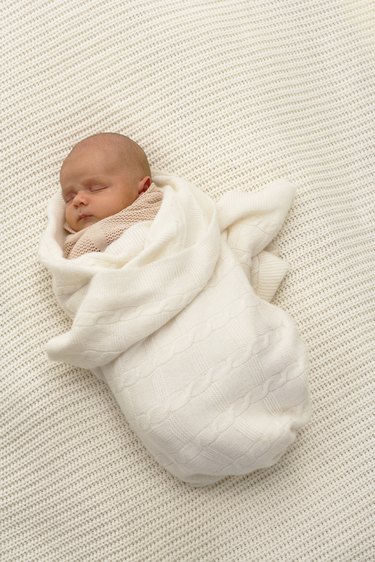Things You'll Need
Two colors of fleece fabric (1 1/4 yards each)
Straight pins
Yardstick
Chalk
Sharp scissors
Coordinating thread
Needle

Hand sewing a baby blanket is an economical and thoughtful way to make a gift for an expectant mother or a newborn in your own family. Provide versatility and give the blanket a different look on each side by making it double-sided. This also increases the warmth. Fleece is an excellent choice for baby blankets and hand-sewn projects since it does not ravel -- therefore it does not require a finish on the edges. It is available in numerous patterns and colors so you can make a double-sided baby blanket with a solid color on one side and a pattern on the other if you desire.
Step 1
Lay the fleece fabric down on top of each other on a flat table or other work surface. The sides that are the most vivid colors are the right sides and they should be facing each other. For instance, place the first piece of fleece with the right side facing up and the second piece of fleece with the right side face down on top of the other.
Video of the Day
Step 2
Pin the edges together with straight pins.
Step 3
Mark a 40-by-40-inch square on top of the fleece with a yardstick and a piece of chalk.
Step 4
Cut the squares out with a pair of sharp scissors.
Step 5
Remove the straight pins and insert them into a pin cushion.
Step 6
Spread the fleece fabrics out flat again with the right sides together. Smooth the materials to ensure there are no wrinkles or creases. Check to ensure the pieces of fleece match exactly. If not, trim any edges with the scissors.
Step 7
Pin the fleece together again with the straight pins along three of the sides.
Step 8
Mark a chalk line along three of the edges -- approximately a half-inch from each side.
Step 9
Thread the needle with a piece of the coordinating thread that you cut approximately 36 inches long. Tie a knot in the end of the thread to enable you to hand sew the blanket.
Step 10
Push the needle into the fleece along the chalk line and bring it up through the other side until the knot catches.
Step 11
Insert the needle back into the fabric approximately 1/4 inch from the first stitch. Pull the needle through the fabric. Repeat the running stitch until you you have sewn to the end of the chalk line. Use neat, tidy stitches. Knot the coordinating thread near the fabric and clip it with the scissors. Repeat this on the other two sides. Rethread the needle once you run out of thread.
Step 12
Knot the thread, and clip it once you are finished hand sewing the three sides.
Step 13
Remove the straight pins.
Step 14
Turn the baby blanket so that the right sides are facing out. Push the corners out with your index finger to create tidy points.
Step 15
Fold the open edges of the baby blanket down 1/2 inch to the inside of the fabric.
Step 16
Sew the edges together with a whip stitch. Do this by pinching the folded ends together and inserting the needle through the bottom of the fabric approximately one-quarter inch from the edge. Bring the needle through the fabric until the knot catches.
Step 17
Place the needle back in the bottom section of the fabric approximately 1/4 to 1/2 inch from the first stitch. Push it back up through the fabric. This creates a decorative and sealed edge on the blanket. Continue the whip stitch to the other end of the blanket.
Step 18
Tie a knot in the thread near the fleece, and then clip the ends with the scissors.
Tip
Use a different color thread for the whip stitch, if you desire. This is because it will show on the finished baby blanket. For instance, if the baby blanket is a pastel green, use a yellow or white thread for the whip stitch.
Fleece launders well. This is particularly important for baby blankets as they require frequent cleaning to ensure the blanket looks attractive and is safe for the baby.
Other fabrics that are useful for lighter weight baby blankets are polyester and soft cotton materials.
Video of the Day